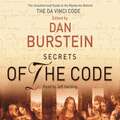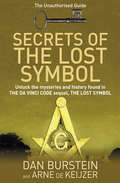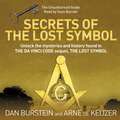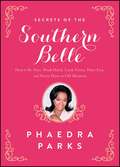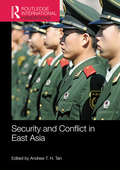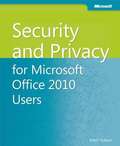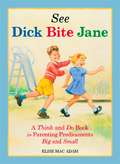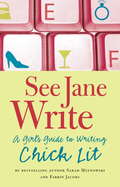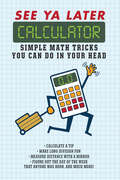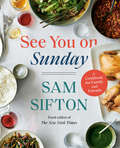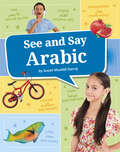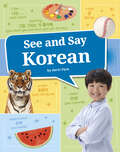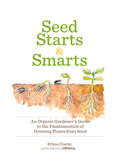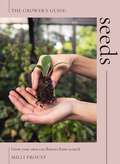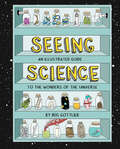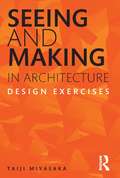- Table View
- List View
Secrets of the Code
by Dan BursteinReaders of Dan Brown's extraordinary bestseller THE DA VINCI CODE are fascinated by the questions raised in the novel. Was Jesus actually married to Mary Magdalene? Was she one of his disciples and did she write her own gospel? Did they have a child together? Did some geniuses of art and science, people like Leonardo da Vinci and Isaac Newton, belong to secret societies that had the most compelling insider information in history, and did Leonardo convey some of these ideas in The Last Supper and other paintings? SECRETS OF THE CODE is the definitive guide to the novel and provides the curious reader with authoritative explorations into the major themes within THE DA VINCI CODE.Read by Sian Thomas and Jeff Harding(p) 2005 Orion Publishing Group
Secrets of the Lost Symbol: The Unauthorised Guide to the Mysteries Behind The Da Vinci Code Sequel
by Sean Barrett Dan Burstein Arne de KeijzerThe first (unauthorised) literary companion to the mysteries behind Dan Brown's latest blockbuster, THE LOST SYMBOL. From the bestselling Secrets team.Delve into a whole new world of secret societies, ancient mysteries, hidden symbols, new-age philosophy and cutting-edge science ... Discover: the role the Freemasons played in US history; the 'real' Katherine Solomon; the true background of the 'Ancient Mysteries'; the reality of Noetic science and much more ...Presenting ideas from world renowned historians, code-breakers, symbologists, theologians, philosophers and scientists, Burstein and de Keijzer break through the web of conspiracies, mythologies, encrypted signs and alternate histories. SECRETS OF THE LOST SYMBOL is a must-read for anyone who wants to separate reality, speculation, fact and fiction in Dan Brown's global phenomenon.
Secrets of the Lost Symbol: The Unauthorised Guide to the Mysteries Behind The Da Vinci Code Sequel
by Sean Barrett Dan Burstein Arne de KeijzerDelve into a whole new world of secret societies, ancient mysteries, hidden symbols, new-age philosophy and cutting-edge science... Discover: the role the Freemasons played in US history; the 'real' Katherine Solomon; the true background of the 'Ancient Mysteries'; the reality of Noetic science and much more...Presenting ideas from world renowned historians, code-breakers, symbologists, theologians, philosophers and scientists, Burstein and de Keijzer break through the web of conspiracies, mythologies, encrypted signs and alternate histories.SECRETS OF THE LOST SYMBOL is a must-read for anyone who wants to separate reality, speculation, fact and fiction in Dan Brown's global phenomenon.Read by Sean Barrett(p) 2010 Orion Publishing Group
Secrets of the Southern Belle: How to Be Nice, Work Hard, Look Pretty, Have Fun, and Never Have an Off Moment
by Phaedra ParksWho is always perfectly put together and never at a loss for words? Who is professional, courteous, and harder working than anyone else? Whose Christmas cards arrive the day after Thanksgiving, year after year? Y'all know she's got to be a Southern Belle. A Southern Belle takes care of herself and makes sure people treat her right. She "always" gets her way, even if her man thinks it was his idea. (That's a win for you both.) But, darling, you don't have to be raised in the South to be the same fun-loving package of looks, charm, and determination that makes a Belle a Belle. That's what this delightful little book is for. Ladies, take it from Phaedra Parks, the smart, confident, and always poised star of "The Real House-wives of Atlanta." Life as a Belle is simply better--for you and for the people around you. So let's imagine you're rocking on the front porch, with a tall glass of sweet tea and a plate of ladyfingers, because Phaedra's got a thing or two to tell you.
Secrets of the Southern Belle: How to Be Nice, Work Hard, Look Pretty, Have Fun, and Never Have an Off Moment
by Phaedra ParksFrom Phaedra Parks, breakout star of The Real Housewives of Atlanta, comes a true Southern Belle's witty, practical, and no-nonsense guide to life.Who is always perfectly put together and never at a loss for words? Who is professional, courteous, and harder working than anyone else? Whose Christmas cards arrive the day after Thanksgiving, year after year? Y'all know she's got to be a Southern Belle. A Southern Belle takes care of herself and makes sure people treat her right. She always gets her way, even if her man thinks it was his idea. (That's a win for you both.) But, darling, you don't have to be raised in the South to be the same fun-loving package of looks, charm, and determination that makes a Belle a Belle. That's what this delightful little book is for! Ladies, take it from Phaedra Parks, the smart, confident, and always poised star of The Real Housewives of Atlanta. Life as a Belle is simply better--for you and for the people around you. So let's imagine you're rocking on the front porch, with a tall glass of sweet tea and a plate of ladyfingers, because Phaedra's got a thing or two to tell you!
Secularism: Law, Policy, and Religious Diversity (Boundaries of Religious Freedom: Regulating Religion in Diverse Societies)
by David KoussensThe increasing visibility of Islam in France and the vehemence of debates about it have often contributed to narrow public perceptions of secularism to a simplistic antireligious crusade, a misleading image disseminated by the media and politicians alike. Taking the opposite stand, this book embarks on a comprehensive effort to document the multiple areas in which French secularism plays out - in debates over “cults,” places of worship, chaplaincy services in public institutions, the recognition of associations of worship, and more -, outlining and analizing the legal paths favored by the state in the regulation of religious diversity. While Islam has undoubtedly contributed to the reshaping of French secularism in the last decades, the book moves beyond what has come to be known as the "Muslim Question" to look at the multiplicity of challenges contemporary religious beliefs, practices, and organizations now pose to the state. David Koussens examines the main political and legal configurations of French secularism over the last thirty years through a sociological and juridical lens, in order to better document its diversity. Such a portrait emphasizes that French secularism is not a univocal phenomenon but one that appears in many guises.
Secure in the Storm: Scriptures For Your Time of Need
by Julie YarbroughThis pocket sized book is a beautiful collection of Scripture verses offering comfort and hope to anyone who is experiencing a time of loss or discouragement. Over 150 promises from the Word of God are conveniently organized into seven categories for quick and easy searching: Assurance Comfort Encouragement Faith Hope Love Peace These encouraging Scriptures will strengthen and sustain those who have lost a loved one or suffered some other kind of loss or personal difficulty, reminding them of the steadfast love and faithfulness of God. A perfect gift for anyone who is grieving or struggling with discouragement.
Securing Your Organization's Future: A Complete Guide to Fundraising Strategies
by Michael SeltzerA step-by-step approach to creating and sustaining a network of funding sources through a discussion of: Major organizational tasks to address before applying for funding How to determine the best mix of funding resources for the long term The use of special events, direct mail, the telephone, planned giving, the Internet, and earned and venture income to obtain support from individual donors How to secure funding support from institutional sources such as foundations, corporations and businesses, government, religious institutions, and others A blueprint for designing and implementing fundraising strategies How to capitalize on the uniqueness of your organization to secure funding
Security Part-1 - IAS Competitive Exam
by Vision IasUpdated Value Additional Material for 2020 IAS examination on topic Security Part 1.
Security and Conflict in East Asia (Routledge International Handbooks)
by Andrew T. TanSecurity and Conflict in East Asia provides a timely and comprehensive analysis of the sources and implications of conflict on the Korean peninsula and in the People’s Republic of China and Japan, the three biggest economies in the world. This analysis provides the building blocks for effective solutions to manage these tensions more effectively, and is a vital resource to those seeking a clearer understanding of conflict in the most pivotal region in the world. In the context of increasingly tense China-US strategic rivalry, the ever-present potential for conflict on the Korean peninsula and over Taiwan, the absence of effective regional institutions and regimes, the emerging arms race in the region, the rise in nationalism and the absence of crisis management mechanisms, there are many good reasons why the high potential exists for miscalculation and misperception sparking a regional conflict. Given the presence of nuclear-armed powers in East Asia, namely, China, North Korea and the USA, it is also possible that any regional conflict could escalate into a nuclear conflict involving the world’s three largest economies: the USA, China and Japan. The security of, and any conflict in, East Asia thus has tremendous implications for global security. The Handbook is divided into four parts. The introductory section includes chapters which set the context, explain the history of international relations in East Asia and examine the phenomenon of regional arms race. The second section is made up of a series of chapters focusing on China, examining China’s military modernization, its relationship with the USA and the various territorial disputes in which it has been involved. The third section focuses on Japan and North and South Korea, looking at the security challenges facing Japan and the Korean peninsula. A concluding section examines the future role of China and the USA in East Asia, as well as the prospects for managing security in the region. The contributing authors are all experts in their respective fields, and all share an abiding concern over developments in East Asia. Their contributions aim to assist in a better understanding of the issues, to suggest possible solutions, and draw attention to the need for diplomacy, confidence-building measures, crisis management mechanisms and other measures to prevent conflict. This volume will be of use to government institutions involved in foreign policy, intelligence and defence, reference libraries, universities, research institutes, and non-governmental organisations. It will also appeal to analysts, researchers, journalists, policy advisers, students, academics and the general reader. Scholarly analysis is yet to catch up and currently there are no other comprehensive works examining conflict in East Asia in the context of the current tensions.
Security and Privacy for Microsoft® Office 2010 Users
by Mitch TullochThis title is also available as a free eBook. Take control--and put the built-in security and privacy features in Microsoft Office to work! Whether downloading documents, publishing a presentation, or collaborating online--this guide offers concise, how-to guidance and best practices to help protect your documents and your ideas.Get practical, proactive guidance for using the security and privacy management features in Office 2010 and Office 365 Walk through everyday scenarios, and discover everyday techniques that help you take charge Understand common risks and learn best practices you can apply right away
Security in IoT-Enabled Spaces
by Fadi Al-TurjmanSecurity and smart spaces are among the most significant topics in IoT nowadays. The implementation of secured smart spaces is at the heart of this concept, and its development is a key issue in the next generation IoT. This book addresses major security aspects and challenges in realizing smart spaces and sensing platforms in critical Cloud and IoT applications. The book focuses on both the design and implementation aspects of security models and strategies in smart that are enabled by wireless sensor networks and RFID systems. It mainly examines seamless data access approaches and encryption and decryption aspects in reliable IoT systems.
See Dick Bite Jane: A Think and Do Book for Parenting Predicaments Big and Small
by Elise Mac Adam"Run, Dick, run!" Now you may be the one who wants to run--but as a parent, it's often from invasive strangers, inconsiderate parents, and well-meaning but overbearing grandparents.See Dick Bite Jane is a primer for handling every parenting pitfall--featuring true tales of "Uh-ohs!" and "Oh, nos!" from moms and dads just like you. Etiquette expert Elise Mac Adam doles out helpful, straightforward advice designed to put bullies in their place--whether those bullies are sandbox strong-arms, nasty neighbors, or your own little angel-turned-devil.A scraped knee? How simple that can be! With the help of Mac Adam (Dick and Jane, too!), you can keep the busybodies and n'er-do-wells at bay with the same confidence--it's as easy as 1, 2, 3!
See Jane Write
by Sarah Mlynowski Farrin JacobsWith chick lit novels popping up on every bestseller list, millions of readers are all thinking the same thing: I could write this stuff. I could write a bestseller and never go back to the office again! And here's the guide that will show you how. Bestselling novelist Sarah Mlynowski and veteran chick lit editor Farrin Jacobs cover every stage of developing and selling your soon-to-be bestselling novel, with information on * developing an idea * learning the basics of plotting * deciding on a point of view * pacing, and conflict * making your characters likable * finding an agent --and much more, including humorous tips and advice from scores of established writers (from Meg Cabot and Marian Keyes to Emily Giffin and Sophie Kinsella). If you've got stories to tell, See Jane Write will take care of the rest!
See No Stranger: A memoir and manifesto of revolutionary love
by Valarie Kaur'Stunning, timely and timeless.' -Elizabeth Gilbert, author of Eat Pray LoveRenowned activist, filmmaker and civil rights lawyer Valarie Kaur made headlines when her 'Breathe and Push' speech on how to survive in a time of rage went viral with 30 million views worldwide. In this inspiring and timely debut, she shows you how to reclaim love as a force for justice.When we practise love in the face of fear or rage, it has the ability to transform an encounter, a relationship, a community, a culture, even a country. Love becomes revolutionary. Revolutionary love is the call of our time. A radical, joyful practice that extends in three directions: to others, to our opponents and to ourselves. It invites you to see no stranger but instead look at others and say: You are part of me I do not yet know.Grounded in Valarie's own personal experience of practising love in the face of political oppression, sexual assault, wrongful arrest, detention, racism and murder, See No Stranger is an important and urgent manifesto that shows us a way to build movements that leave no one behind. You will learn to love others without prejudice or judgement, love your opponents through empathy and forgiveness, and ultimately to love yourself.*****Reviews'Valarie Kaur is a prophetic voice of our generation. Her wisdom ignites and inspires me, lighting the way through the darkness. This book will do the same for you.' -America Ferrera, actress and activist'Valarie Kaur is a visionary worker for justice and this book is her radiant offering.' -Eve Ensler, author of The Vagina Monologues'See No Stranger is rooted in radical honesty, vulnerability, and fierce commitment to building a world in which we all belong.' -Michelle Alexander, author of The New Jim Crow'This is the book we have been waiting for. It calls us up and calls us into the hard and necessary work to heal our wounds and reimagine the world.' -Van Jones, CEO of REFORM Alliance and CNN host'Love-firebrand... Part personal history, part inspiring manifesto, Kaur's immensely readable book implores and inspires us toward love as "sweet labor: bloody, fierce, imperfect, and life-giving."' -Rainn Wilson, actor
See No Stranger: A memoir and manifesto of revolutionary love
by Valarie Kaur'In a world stricken with fear and turmoil, Valarie Kaur shows us how to summon our deepest wisdom.' -Elizabeth Gilbert, author of Eat Pray LoveRenowned activist, filmmaker and civil rights lawyer Valarie Kaur made headlines when her 'Breathe and Push' speech on how to survive in a time of rage went viral with 30 million views worldwide. In this inspiring and timely debut, she shows you how to reclaim love as a force for justice.When we practise love in the face of fear or rage, it has the ability to transform an encounter, a relationship, a community, a culture, even a country. Love becomes revolutionary. Revolutionary love is the call of our time. A radical, joyful practice that extends in three directions: to others, to our opponents and to ourselves. It invites you to see no stranger but instead look at others and say: You are part of me I do not yet know.Grounded in Valarie's own personal experience of practising love in the face of political oppression, sexual assault, wrongful arrest, detention, racism and murder, See No Stranger is an important and urgent manifesto that shows us a way to build movements that leave no one behind. You will learn to love others without prejudice or judgement, love your opponents through empathy and forgiveness, and ultimately to love yourself.(p) 2020 Octopus Publishing Group
See Ya Later Calculator: Simple Math Tricks You Can Do in Your Head
by Editors of Portable PressThe math book for anyone who thinks they hate math, full of easy, entertaining and practical tricks for mentally solving problems in seconds.No matter how much you might try to avoid numbers, we all use math every day to calculate a tip, figure out an interest rate, or estimate the cost of the groceries in your cart. But the good news is, math can be easy—and even fun—if you know how to do it all in your head.With these simple and downright magical math tricks, you can do everyday math faster than it takes to dig out your phone and find the calculator app. Step-by-step and easy-to-memorize directions show more than 125 math operations anyone can do in their head.Plus, it features do-it-yourself math projects, puzzles, and a bonus section for advanced mathophiles. Get ready to tackle problems such as . . .• How to easily square any number • How to add three-digit numbers • How to use a mirror to measure the height of a building • How to make a ruler out of a dollar bill • How to use geometry to paint walls, cut floor tiling, and do other home renovations • How to subtract numbers . . . by adding And lots more . . . No calculator required.
See You on Sunday: A Cookbook for Family and Friends
by Sam SiftonFrom the New York Times food editor and former restaurant critic comes a cookbook to help us rediscover the art of Sunday supper and the joy of gathering with friends and family &“A book to make home cooks, and those they feed, very happy indeed.&”—Nigella Lawson&“People are lonely,&” Sam Sifton writes. &“They want to be part of something, even when they can&’t identify that longing as a need. They show up. Feed them. It isn&’t much more complicated than that.&” Regular dinners with family and friends, he argues, are a metaphor for connection, a space where memories can be shared as easily as salt or hot sauce, where deliciousness reigns. The point of Sunday supper is to gather around a table with good company and eat.From years spent talking to restaurant chefs, cookbook authors, and home cooks in connection with his daily work at The New York Times, Sam Sifton&’s See You on Sunday is a book to make those dinners possible. It is a guide to preparing meals for groups larger than the average American family (though everything here can be scaled down, or up). The 200 recipes are mostly simple and inexpensive (&“You are not a feudal landowner entertaining the serfs&”), and they derive from decades spent cooking for family and groups ranging from six to sixty.From big meats to big pots, with a few words on salad, and a diatribe on the needless complexity of desserts, See You on Sunday is an indispensable addition to any home cook&’s library. From how to shuck an oyster to the perfection of Mallomars with flutes of milk, from the joys of grilled eggplant to those of gumbo and bog, this book is devoted to the preparation of delicious proteins and grains, vegetables and desserts, taco nights and pizza parties.
See and Say Arabic (Learn a Language!)
by Susan Muaddi DarrajOffering simple phrases and key vocabulary, this book will help readers start learning Arabic.
See and Say Korean (Learn a Language!)
by Aerin ParkOffering simple phrases and key vocabulary, this book will help readers start learning Korean.
Seed Starts & Smarts: An Organic Gardener's Guide to the Fundamentals of Growing Plants from Seed
by Organic Gardening Ethne ClarkeWhether broadcast across a prepared seedbed or tucked into a container of growing medium, seeds hold the promise of something much bigger--juicy tomatoes, lush foliage, and brilliant blossoms. And growing plants from seed is easy and inexpensive (as well as rewarding) for the gardener ready to try new or regional varieties. Seed Starts & Smarts features sowing and growing advice for more than 70 edible garden crops--including vegetables, herbs, and fruits--along with tips and techniques for growing the most popular ornamentals from seed, region-specific information, and general timing guidelines.
Seeds of Resistance: The Fight to Save Our Food Supply
by David Talbot Mark SchapiroSun. Soil. Water. Seed. These are the primordial ingredients for the most essential activity of all on earth: growing food. All of these elements are being changed dramatically under the pressures of corporate consolidation of the food chain, which has been accelerating just as climate change is profoundly altering the conditions for growing food. In the midst of this global crisis, the fate of our food has slipped into a handful of the world’s largest companies. Food Chained will bring home what this corporate stranglehold is doing to our daily diet, from the explosion of genetically modified foods to the rapid disappearance of plant varieties to the elimination of independent farmers who have long been the bedrock of our food supply.Food Chained will touch many nerves for readers, including concerns about climate change, chronic drought in essential farm states like California, the persistence of the junk food culture, the proliferation of GMOs, and the alarming domination of the seed market and our very life cycle by global giants like Monsanto.But not all is bleak when it comes to the future of our food supply. Food Chained will also present hopeful stories about farmers, consumer groups, and government agencies around the world that are resisting the tightening corporate squeeze on our food chain.
Seeds: Grow Your Own Cut Flowers from Scratch (The Grower's Guide)
by Milli ProustFrom sowing and germination, to sprouting, repotting and harvesting, The Grower’s Guide: Seeds is a modern and practical handbook that will take you through all the essential steps to growing your own cut flowers from seed. Beautifully photographed throughout, this essential guide demystifies the growing process through simple, easy-to-follow instructions, defined by Milli Proust’s unique sense of style. Featuring a sowing directory of 30 flowers to grow, learn how to get the most from your soil, tackle common gardening problems, and produce beautiful blooms in a sustainable way.The Grower's Guide is a brand new gardening series for those who seek an approachable and accessible insight into the wonderful world of flower growing and floral arranging.
Seeing Science: An Illustrated Guide to the Wonders of the Universe
by Iris GottliebFrom an illustrator for San Francisco’s Exploratorium, a visual journey that shows how beautiful science really is.With original illustrations that deftly explain the strange-but-true world of science, Seeing Science offers a curated ride through the great mysteries of the universe. Artist and lay scientist Iris Gottlieb explains among other things: neap tides, naked mole rats, whale falls, the human heart, the Uncertainty Principle, the ten dimensions of string theory, and how glaciers are like Snickers bars. With quirky visual metaphors and concise factual explanations, she offers just the right amount of information to stoke the curious mind with a desire to know more about the life forces that animate both the smallest cell and the biggest black hole. Seeing Science illustrates, explicates, and celebrates the marvels of science as only art can.
Seeing and Making in Architecture: Design Exercises
by Taiji MiyasakaYou always aim to achieve that moment of insight that leads to ingenuity and novelty in your design, but sometimes it remains elusive. This book presents a variety of techniques for mapping and making hands-on design/build projects, and relates this work to real architecture. It helps you to learn new ways of seeing and making that will enhance your creative design process and enable you to experience moments that lead to ingenuity in design. Each of the book’s two parts, "Seeing" and "Making," is organized according to technique, which ranges from quantitative analysis and abstraction to pattern and scale, to provide you with a framework for mapping and hands-on exercises. Interviews with architects Yoshiharu Tsukamoto (Atelier Bow-Wow) and Jesse Reiser and Nanako Umemoto (Reiser + Umemoto) give you perspective on using these exercises in practice.
